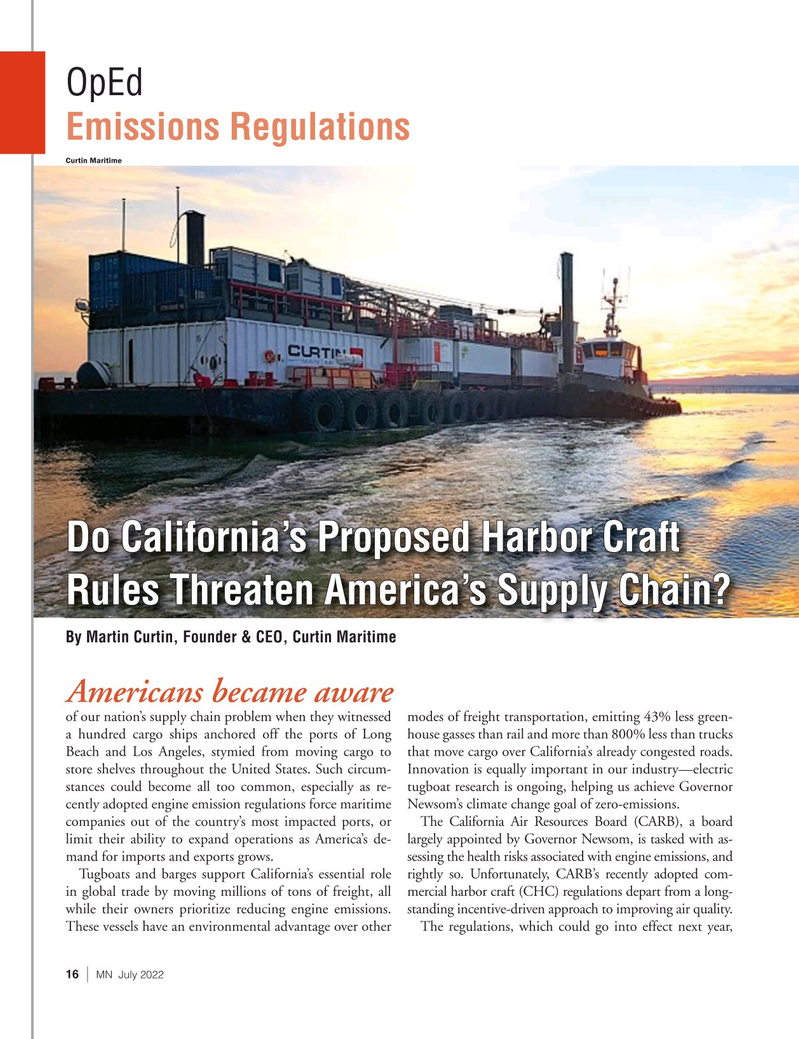
Page 16: of Marine News Magazine (July 2022)
Propulsion Technology
Read this page in Pdf, Flash or Html5 edition of July 2022 Marine News Magazine
OpEd
Emissions Regulations discount the importance of best available science, econom- Moreover, CARB assumes that engine manufacturers ic feasibility and public safety. CARB’s regulations man- can meet the immediate need for engine technology that date engines and technology that either do not exist or are currently does not exist, and that ship builders located in too large, requiring vessels to undergo major reconstruc- other states are prepared to accept boat orders and can tion or worse yet, cause vessels that cannot structurally make deliveries by the time the regulations start going into comply to be removed from service. The cost of compli- effect in January 2023.
ance is in the millions of dollars per vessel, well beyond the If the Newsom Administration is to achieve its zero- reach of most family-operated businesses. emission goals without causing serious disruption to
Experts in the ? eld believe this new approach results America’s supply chain and increasing in? ationary pres- from CARB’s ? awed engine emission data. CARB in? ates sures, this is the year for the State Legislature to make sure the number of vessels and the time they spend in regulated the Governor’s budget suf? ciently funds lower emission waters, and fails to understand how vessels operate. We are engine programs and earmarks funds speci? cally for har- concerned that they overstate health risks, especially when bor crafts. Anything short of this will reduce the inventory assigning health risks to vessels that spend a majority of of operating tugboats, placing America’s supply chain at their time many miles from shore. serious risk the next time large cargo ships wait in our Na-
The use of diesel particulate ? lters (DPFs) required by tion’s largest ports for harbor escorts.
CARB compounds safety risks. Currently, there are no
DPFs for commercial marine applications. DPFs found on tractor trailer trucks have been known to cause inop- portune and dangerous decreases in engine performance for extended periods of time as ? lters clog, and in some cases, catch ? re. Such incidents could be life threatening at sea and pose a secondary threat to vessels containing pet- rochemical products as fuel or cargo. Our mariners cannot just pull over or get out and walk away like truck drivers do when their DPFs malfunction. Before mandating DPF, the technology should be certi? ed by engine manufactur- ers and the U.S. Coast Guard as safe.
To be clear, the industry never called on CARB to aban- don its goal of updating current air quality standards. In fact, many vessel owners would have supported more strin- gent regulations provided the technology was available and the compliance timeline was reasonable.
Unfortunately, CARB passed unreasonable amend- ments. Now vessel companies question whether the State’s
Carl Moyer Program, which provides grants for lower emission engines and vessel replacement, is prepared for unprecedented demand for funding. The state program is seriously underfunded and historically the local air dis- tricts that allocate the funds favor other industries. Our industry alone will require over $1.3 billion dollars to replace engines, which does not account for the expense of vessel replacement ($15-$25 million per a tug) and emerging technology.
www.marinelink.com MN 17|

 15
15

 17
17
